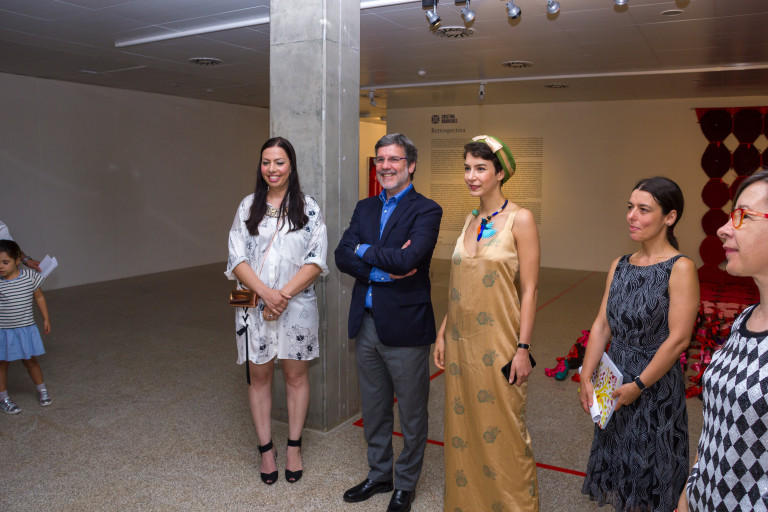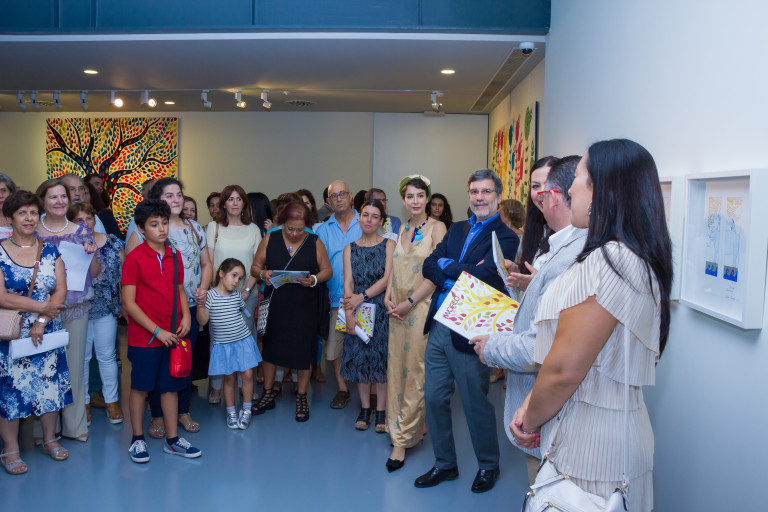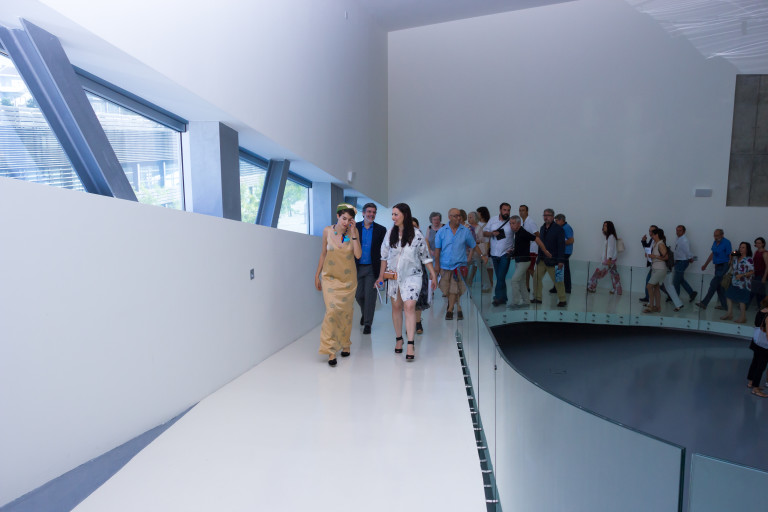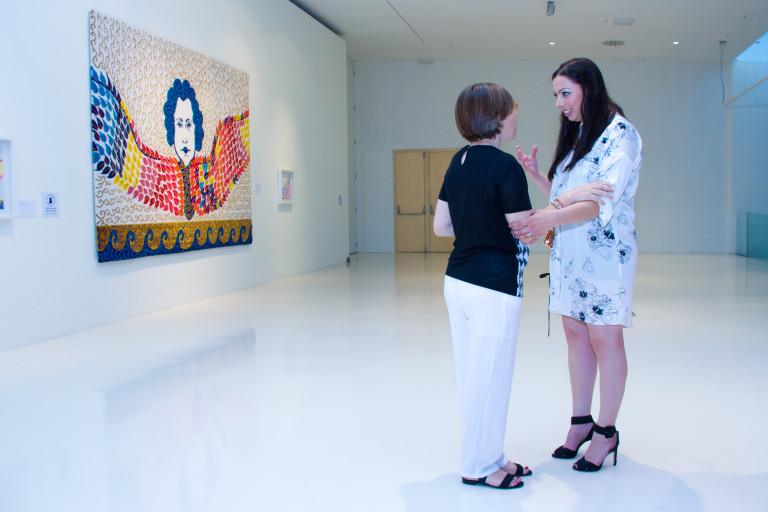Cristina Rodrigues Retrospective | Castelo Branco, Portugal
I showed one of Cristina’s large Blanket pieces at a group exhibition at TIL Gallery years ago. We kept in touch and I saw her produce relentlessly and ambitiously and intelligently. So when she asked me to curate her retrospect, it was a pleasure. Somehow Portugal keeps calling me, or I keep circling back to it. The opening night at the special old town where the large, slick Castelo Branco Cultural Centre stood in, was full of curious eyes, conversations and colours (July/15/2017). Complete with the mayor in attendance and me speaking through a translator to a crowd of a few hundred, which was… new.
We are organising a one-day exhibition for a few of her other pieces here in London in September. Will keep you posted.
xo
t.a
-my curatorial statement for the show below-
Cristina Rodrigues is a storyteller; she weaves, draws, arranges, finds, intervenes, repeating over and over colorful tales that are both dramatic and controlled, abstract yet full of meaning.
About
Her approach is that of a seance, as she revives old objects with new objectives. In her Desert series, for example, she uses chairs that belonged to immigrant families in the United Kingdom, adorning each with her signature bright ribbons, the loose ends of which dangle like branches of a tree or the mane of wild horses. After a life of servitude and solidarity in the intimacy of displaced families, the unwanted chairs are now elevated to art and hung on walls with an organic radiancy. Below each are porcelain feet, completing the image of the chairs as both travelers and observing beings.
In this process of transformation, her mediums of choice – tapestry, embroidery, porcelain work – are often redolent of traditional technologies and masterful techniques, many of which have slowly been set aside in lieu of present-day efficiency. “I like using objects with a memory, things that people stopped valuing because they’re not fashionable anymore – objects that were replaced,” Cristina says. Despite such nostalgic themes, the artist’s aesthetic is fiercely contemporary.
Take The Lovers series, where realistic ceramic hearts are trapped in freezing bags and hung from metal bars with shreds of red or white ribbons dangling off the hooks; it’s grotesque and raw yet sterile and inviting. Similarly, Dining the Heart is a visceral immersion into a living room of ribbons as if escaping into a child’s imagination. At first, the primary colors evoke a sense of innocence, vitality and happiness. But soon we notice the inevitable opposition that is staring back at us, that of loss.
In all her works, repetition is key. Whether they are La Pasión’s woven ribbons circulating round and round a wooden parameter, the intricate tapestry and embroidery (The Garden of Eden), or the hundreds of shoes in formation on the floor (In Your Shoes / Urban Dwellers), the impact of their collective iterations is emphasized. Like how myriads of tiny stitches in particular positions and shades ultimately amount to a landscape, a picture, a story, the long and arduous process of creation is as fascinating as the end result. Each ribbon tied, object placed, and sculpture made is a visual representation of the time that the artist (or artisans) have spent on the piece. This sense of awareness is not limited to the artwork alone, as Cristina frequently highlights the story of people attached to her work: the previous owners, the linen weavers from Várzea de Calde who collaborated on The Shroud especially for Colombo Art Biennale 2016, or the Portuguese artisans who helped conceive The Blanket Amarantina, acquired by the Municipal Museu Amadeo de SouzaCardoso.
In many ways, Cristina’s artistic universe exceeds her individualism, and becomes the speculative experience of craftsmanship and imagination, coalesced in this moment and time, and often in a significant setting. Her site-specific works gain another layer of meaning depending on the environment they are presented in. She has exhibited in monasteries (Santa Maria de Alcobaca, Portugal), palaces (S. Clemente Palace, Brazil), cathedrals (Manchester Cathedral, U.K), and now in the historic Castelo Branco. Between 18th and 19th century, the lavish and decadent art of embroidery emerged in Castelo Branco, inspiring the material and techniques used in the embroidery and tapestries on display. The first Castelo Branco embroidered coverlets appeared during Portugal’s Imperial period, and present two really strong influences in the selected motifs: coverlets inspired by Southern Chinese style and the ones referencing Southern Indian icons.
In each room of the exhibition, viewers are offered the seclusion, design, and precision of light and shadow to engage with the artwork. Instead of relying on the blandness of white walls to stand out, these pieces use the rich history, palette, and architecture of their surroundings to incur a variety of stories. This expansive approach is perhaps a souvenir from Cristina’s studies in medieval and renaissance history, which have made bare to her the unspoken histories entrenched within structures. Cristina’s attention to voices of the past invites viewers to do the same and become a part of the exhibition rather than mere observers. Such surreal, sensory engrossments are amplified not just by the quantity of individual parts of a given artwork but also by their scale, another strong feature of Cristina’s works. Her textile creations may cover entire rooms and halls (her Blanket installations go as high as 7 meters), the result of a fearless exploration of space that can be traced back to her architectural studies. And yet, all her work, no matter how large or small, start on paper with her original obsession: drawing. The large-scale drawings shown are different representations of the Tree of Life, an ancient and popular theme used in Castelo Branco Embroidery.
The allusions to angels in these series is her interpretation of the baroque angels that are common in Portuguese tiles. Again, the enduring transcendence of a myth through different mediums and ages. In this retrospective, time, space, and repetition are the metaphysics that bind the works together, showcasing the artist’s oeuvre as her narratives cut through multiple cultures, places, and media. The selected works are materializations of Cristina’s passions and obsessions, “in a balance between moments of contentment and those of suffering.”
Curatorial statement by Tara Aghdashloo



